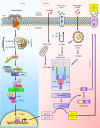Differential role of the NLRP3 inflammasome in infection and tumorigenesis
- PMID: 30666624
- PMCID: PMC6418426
- DOI: 10.1111/imm.13046
Differential role of the NLRP3 inflammasome in infection and tumorigenesis
Abstract
Dysregulated inflammation is one of the hallmarks of cancer initiation and progression. Emerging evidence indicates that inflammasomes play a central role in regulating immune cell functions in various infections and cancer. Inflammasomes are multimeric complexes consisting of nucleotide-binding oligomerization domain (NOD) -like receptors (NLRs). Among the NLRs, NOD1, NOD2 and NLRP3 respond to a variety of endogenous (i.e. damage-associated molecular patterns) and exogenous (i.e. pathogen-associated molecular patterns) stimuli. The NLRP3 inflammasome is associated with the onset and progression of autoinflammatory and autoimmune diseases, including metabolic disorders, multiple sclerosis, inflammatory bowel disease, and cryopyrin-associated periodic fever syndrome. NLRP3 is also associated with a wide variety of infections and tumorigenesis that are closely correlated with chemotherapy response and prognosis. In this review, we explore the rapidly expanding body of research on the expression and functions of NLRP3 in infections and cancers and outline novel inhibitors targeting the NLRP3 inflammasome that could be developed as therapeutic alternatives to current anticancer treatment.
Keywords: inflammasome; inflammation; tumorigenesis.
© 2019 John Wiley & Sons Ltd.
Figures

References
-
- Janeway CA Jr. Approaching the asymptote? Evolution and revolution in immunology. Cold Spring Harb Symp Quant Biol 1989; 54(Pt 1):1–13. - PubMed
-
- Takeuchi O, Akira S. Pattern recognition receptors and inflammation. Cell 2010; 140:805–20. - PubMed
-
- Akira S, Takeda K. Toll‐like receptor signalling. Nat Rev Immunol 2004; 4:499–511. - PubMed
-
- Kawai T, Akira S. Toll‐like receptors and their crosstalk with other innate receptors in infection and immunity. Immunity 2011; 34:637–50. - PubMed
-
- Akira S, Uematsu S, Takeuchi O. Pathogen recognition and innate immunity. Cell 2006; 124:783–801. - PubMed
Publication types
MeSH terms
Substances
Grants and funding
LinkOut - more resources
Full Text Sources
Other Literature Sources

